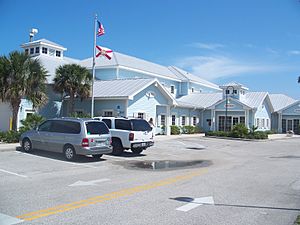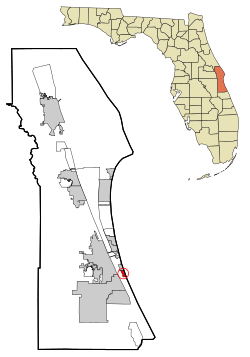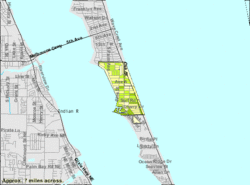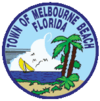Melbourne Beach, Florida facts for kids
Quick facts for kids
Melbourne Beach, Florida
|
||
|---|---|---|
| Town of Melbourne Beach | ||

Town hall
|
||
|
||

Location in Brevard County and the state of Florida
|
||

U.S. Census Bureau map showing town boundaries
|
||
| Country | ||
| State | ||
| County | Brevard | |
| Incorporated | 1923 | |
| Government | ||
| • Type | Commission-Manager | |
| Area | ||
| • Total | 1.40 sq mi (3.63 km2) | |
| • Land | 0.99 sq mi (2.56 km2) | |
| • Water | 0.41 sq mi (1.07 km2) | |
| Elevation | 10 ft (3 m) | |
| Population
(2020)
|
||
| • Total | 3,231 | |
| • Density | 3,270.24/sq mi (1,263.18/km2) | |
| Time zone | UTC-5 (Eastern (EST)) | |
| • Summer (DST) | UTC-4 (EDT) | |
| ZIP code |
32951
|
|
| Area code(s) | 321 | |
| FIPS code | 12-44000 | |
| GNIS feature ID | 0286684 | |
Melbourne Beach is a small town in Brevard County, Florida, United States. It's part of a larger area that includes Palm Bay, Melbourne, and Titusville, Florida. In 2020, about 3,231 people lived here. This makes it a quiet, friendly place to live or visit.
Contents
History of Melbourne Beach
Melbourne Beach is the oldest beach community in Brevard County. It has a long and interesting past, from ancient times to today.
Who lived here first?
Long ago, before Europeans arrived, the Ais Indians lived in this area. They were the first residents of what is now Melbourne Beach. In 2010, an old shell mound (called a midden) was found near a place called Aquarina. It contained a burial site for an important chief and two helpers.
Did Ponce de León land here?
Some people believe that Juan Ponce de León might have landed near Melbourne Beach in 1513. If true, he would have been the first European to step foot in Florida. A historian in the 1990s thought this spot was very close to where he landed. However, most historians agree that it's hard to know the exact landing spot. A statue of Ponce de León was put up at "Juan Ponce de León Landing" in Melbourne Beach to remember his journey.
How did Melbourne Beach grow?
In 1879, a hotel called the Oak Lodge was built. It was a place for scientists and nature lovers. Later, in 1921, the Melbourne Causeway was built. This bridge connected Melbourne Beach to the mainland through the town of Indialantic. Just two years later, in 1923, Melbourne Beach officially became a town.
In 1928, a pilot named Harry J. Brooks had an aviation accident off the coast of Melbourne Beach while trying to set a long-distance flying record.
The town's population changed a lot until World War II. After the war, more and more people started moving to Melbourne Beach. Today, it's mostly a residential area with homes, an elementary school, and some local businesses. It's known as a great place for people to retire. In 2016, a store nearby sold one of the winning tickets for a huge Powerball lottery prize!
Geography and Climate
Melbourne Beach is located on a narrow strip of land called a barrier island. This island separates the Indian River Lagoon from the Atlantic Ocean. The island is about 40 miles (64 km) long. To the north, Melbourne Beach borders the town of Indialantic.
What is the size of Melbourne Beach?
The town covers a total area of about 1.3 square miles (3.3 square kilometers). Most of this area, about 1.0 square mile (2.7 square kilometers), is land. The rest, about 0.2 square miles (0.6 square kilometers), is water.
What is the weather like?
Melbourne Beach has a humid subtropical climate. This means it has mild winters and hot, humid summers. It's a great place for enjoying the outdoors almost all year round!
| Climate data for Melbourne Beach A1A, Florida, 1991–2020 normals | |||||||||||||
|---|---|---|---|---|---|---|---|---|---|---|---|---|---|
| Month | Jan | Feb | Mar | Apr | May | Jun | Jul | Aug | Sep | Oct | Nov | Dec | Year |
| Mean daily maximum °F (°C) | 70.5 (21.4) |
71.9 (22.2) |
75.5 (24.2) |
80.1 (26.7) |
83.7 (28.7) |
87.4 (30.8) |
89.5 (31.9) |
89.5 (31.9) |
87.7 (30.9) |
83.5 (28.6) |
77.5 (25.3) |
72.3 (22.4) |
80.8 (27.1) |
| Daily mean °F (°C) | 62.1 (16.7) |
63.9 (17.7) |
67.4 (19.7) |
72.4 (22.4) |
76.5 (24.7) |
80.2 (26.8) |
81.8 (27.7) |
82.1 (27.8) |
81.1 (27.3) |
77.0 (25.0) |
70.5 (21.4) |
65.0 (18.3) |
73.3 (22.9) |
| Mean daily minimum °F (°C) | 53.6 (12.0) |
55.9 (13.3) |
59.3 (15.2) |
64.6 (18.1) |
69.3 (20.7) |
72.9 (22.7) |
74.1 (23.4) |
74.6 (23.7) |
74.5 (23.6) |
70.5 (21.4) |
63.5 (17.5) |
57.7 (14.3) |
65.9 (18.8) |
| Average precipitation inches (mm) | 2.66 (68) |
2.42 (61) |
1.68 (43) |
2.47 (63) |
4.17 (106) |
5.50 (140) |
5.20 (132) |
4.87 (124) |
7.55 (192) |
4.90 (124) |
2.61 (66) |
2.49 (63) |
46.52 (1,182) |
| Source: NOAA | |||||||||||||
What animals live here?
Melbourne Beach is home to many interesting animals, especially birds. You might see black-bellied plovers and red knots (in winter) along the shore. Gannets and other seabirds can be spotted offshore. In winter, you might even see red-throated loons.
Population and People
The number of people living in Melbourne Beach has changed over the years. It has grown quite a bit since the 1930s.
| Historical population | |||
|---|---|---|---|
| Census | Pop. | %± | |
| 1930 | 72 | — | |
| 1940 | 90 | 25.0% | |
| 1950 | 230 | 155.6% | |
| 1960 | 1,004 | 336.5% | |
| 1970 | 2,262 | 125.3% | |
| 1980 | 2,713 | 19.9% | |
| 1990 | 3,021 | 11.4% | |
| 2000 | 3,335 | 10.4% | |
| 2010 | 3,101 | −7.0% | |
| 2020 | 3,231 | 4.2% | |
| U.S. Decennial Census | |||
Who lives in Melbourne Beach?
In 2020, there were 3,231 people living in Melbourne Beach. These people lived in 1,374 households, with 874 of them being families. Most residents are White, but the town is becoming more diverse.
| Race | Pop 2010 | Pop 2020 | % 2010 | % 2020 |
|---|---|---|---|---|
| White (NH) | 2,919 | 2,892 | 94.13% | 89.51% |
| Black or African American (NH) | 14 | 13 | 0.45% | 0.40% |
| Native American or Alaska Native (NH) | 6 | 0 | 0.19% | 0.00% |
| Asian (NH) | 33 | 24 | 1.06% | 0.74% |
| Pacific Islander or Native Hawaiian (NH) | 0 | 0 | 0.00% | 0.00% |
| Some other race (NH) | 2 | 10 | 0.06% | 0.31% |
| Two or more races/Multiracial (NH) | 27 | 105 | 0.87% | 3.25% |
| Hispanic or Latino (any race) | 100 | 187 | 3.22% | 5.79% |
| Total | 3,101 | 3,231 |
Many people in Melbourne Beach have roots from different parts of the world. In 2015, the largest groups of people reported their ancestry as English, German, Italian, and Irish.
Economy and Tourism
Melbourne Beach is a well-off community. In 2010, the average income for a household was $87,035. The average home value was $321,498. This makes Melbourne Beach one of the wealthiest places in Brevard County based on income per person.
What can you do for fun?
Tourism is important in Melbourne Beach.
- Coconut Point Park: This is a large beachside park, about 36.9 acres (14.9 hectares). It's a special place for sea turtles to lay their eggs. The park is also part of the Great Florida Birding Trail, making it a great spot for birdwatching.
Places to Visit
Melbourne Beach has several interesting spots to check out:
- Melbourne Beach Pier
- Old Melbourne Beach Town Hall
- Ryckman Park
Famous People from Melbourne Beach
Many notable people have lived in or are connected to Melbourne Beach:
- Bobby Dall: Musician, bass player for the rock band Poison.
- Jorja Fox: American actress and producer.
- Doug Flutie: Famous football player.
- Caroline Marks: An Olympic surfer.
- Pat Neshek: A pitcher who played for the St. Louis Cardinals baseball team.
- Kate Chastain: A reality TV star known from the show “Below Deck.”
Images for kids
See also
 In Spanish: Melbourne Beach para niños
In Spanish: Melbourne Beach para niños






